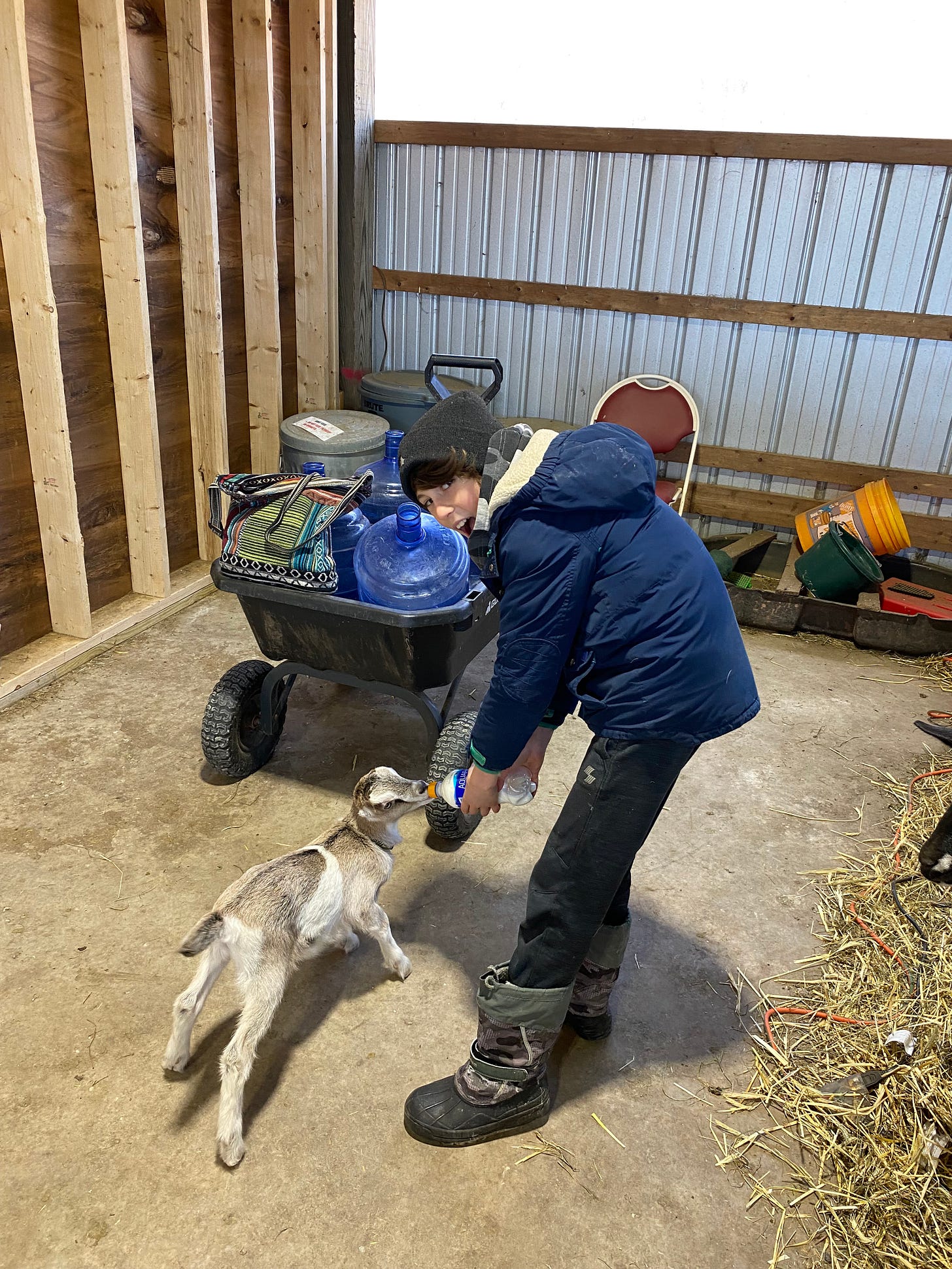
Readers, it has been a while–a whole fall and winter have nearly passed, and we are almost to spring. There’s no time to catch up on everything, but things have been busy, and–who knew how hard a transition to new jobs, new state, new schools would be? (Just kidding, of course it would be hard, but I just didn’t think of the extent of its difficulty!). Alas, we are overall doing fine here, albeit working a lot–Alex is doing good things at his job of Farm Director, and I got a job teaching at the farm school, which I have been doing since September, where many of my students are nonverbal autistic teenagers. Though there are farm chores to do with them, I am not doing as much farming as I would like, and March is really when I really start getting the itch–the moment I see the crocuses begin to burst through earth is when I start to think about all of the perennials and infrastructure we left at our old place, wishing I had some of that now.
But! No time to be sad about the past. I also don’t want to talk too much about the future, for I am trying to just be ever-present in the now. We are still trying to figure out things and I promise to be more update-y whenever things take shape; for now, though, I am just concentrating on getting through the school year, and attempting to think positive. One nice thing about my current job is that it does allow me to leave work and pick up the boys from school (on foot), then come home to cook dinner, which is what I look forward to everyday.
With that, I have started to master the art of the quick, healthy dinner. Paid subscriptions will be starting up again soon (!!), and one of the first posts I am working on is “The Medicinal Pantry”, which will talk about quick meals that can be thrown together using some pantry staples you can get or already have on hand. More stuff in the works, too!
I had been thinking of the quick, healthy, budget-friendly, climate-friendly dinner for a while, taking notes and doing research, when I read about Kellogg’s tone-deaf campaign to encourage cash-strapped families to “eat cereal for dinner”. At first, I thought it was a parody; it just seemed a little too YA Dystopian Novel to think of the Kellogg’s CEO, in his golden palace eating lamb stew, telling the commoners they should just chow down on a bowl of corn flakes to save money. After a quick youtube search, though, I am sorry to say that it is a real commercial, one that received a well-deserved amount of backlash.
Many, many problems, of course, underscore this idea, as others have pointed out. Firstly, a box of cereal is not that inexpensive for a lower-income family trying to get dinner on the table. (A package of tempeh, a head of broccoli and a bag of rice can be bought for roughly the same price of a cereal box, not to mention the milk.) Then there is the problem with nutrition and the actual cost of health, in which processed breakfast food is abysmal and should be avoided even in the morning (I say this as someone whose bones and body were built as a child by Frosted Flakes and Lucky Charms). Aside from these cereals not being good for you to eat for any meal, they are also terrible for the environment. I agree with the social media campaign to boycott Kellogg’s cereals (#LetThemEatCereal), pointing out the atrocious wealth gap in our ugly, circuitous capitalist society, but people who are boycotting Kellogg’s for the sake of them to lower their prices are missing the point.
Processed foods commit numerous environmental crimes, from the pesticide-ridden, water-guzzling, soil-destroying components of using cocoa, sugar, and GMO grains (not to mention the imperialism of its use of unfair labor practices and modern-day slavery). The cereal factories themselves also take a horrendous amount of energy, with its grinding, boiling, and puffing of making crispy cereal bites (energy currently derived from coal plants until alternative energies take root). Lessening the price of an $8 box of cereal only feeds into labor abuse, from the harvesting of cocoa beans to the machine labor in a polluting factory; yes, Walmart has cheaper prices and Tyson makes cheap frozen chicken nuggets, but by paying those cheaper prices, you are simply supporting their exploitive labor and encouraging the suffering of workers, animals, and the environment.
There are many alternatives to a fast, cheap-ish dinner that don’t involve processed flakes in a plastic bag in a box. If we are going with the breakfast theme, eggs are nutrient powerhouses. Springtime is when we should remember the humble egg (it traditionally being a seasonal food) and you can find good ones almost everywhere. In the beginning of March, even though there are chickens on the farm here and I do chicken chores every week with my students, somehow it wasn’t enough, and my overdoing-it brain made me order a small flock of chickens to just have in our backyard so the boys can collect their own eggs, as well as for pest control and manure for a tiny garden this year. (Always a homeschool teacher, I also thought it would be fun for the boys to learn to build a chicken coop from old scraps of wood!). We currently have very little space in the yard (we will see how this goes), and I know that raising a flock of seven chickens is not exactly possible for someone in an apartment, but buying a dozen eggs from a local farmer at roughly the same price of a box of cereal sure beats Cheerios for a meal in every single way: nutritionally, environmentally, and sustainably speaking. I understand that corporations have no moral core, but if people as rich and powerful as the Kellogg’s CEO actually cared about poor people getting dinner on the table instead of filling their own wallets, then something like local eggs would be the option that would be shared in the news. The suffering of living things everywhere is overwhelming, but sometimes making simple, healthy, earth- and labor- friendly choices can be as easy and inexpensive as making a quick egg-and-veggie scramble for dinner.
What I am Cooking:
Many things will be coming to this newsletter! I have been practicing making my own pantry and refrigerator staples. We are coming out of everyone in this house being sick, and this past Sunday, even though the sky was the color of ashes and everything felt very gloomy, I put on a podcast and made most things on my list. I mean, it took me most of the day and I was definitely wiped out, but I made a sourdough focaccia, a jar of homemade chili crisp, cookies for a school fundraiser, and a gallon of hazelnut milk from these local hazelnuts I got forever ago. I also made a vegetable root au gratin and roasted a chicken, and I felt very accomplished; mind you, again, this is the most I have made on a Sunday in a very long time, so calm down! But it gave me lots of ideas of how-to tutorials to film, so I am excited about that.
Winter time is time for cooking lots of stews, in my opinion, when winter can be cozy but sometimes too dark; I am really ready for the transition into spring. For months, we have been living off what we have preserved, from our fermented jars, our canning jars, our freezer, our pantry, and our mini “root cellar”. I enjoy knowing I have plenty of canned beets and frozen green beans to get me through February (as I have talked about often, I have always secretly been Laura Ingalls Wilder in The Long Winter—good at eating when times are less plentiful! Or maybe I’m just a prepper). Though we had spinach and kale in the hoop houses for most of the cold months, February and March have long been my toughest months to get through, waiting for other green things to burst out of the ground again, for snow to melt, for life to wake up. And with a long winter and climate change and food injustice compacting everything, sometimes already-low thoughts can melt into depression and only get twisted up in misery, so much so it just makes me want to give up and throw my wooden spoon against the wall in a “isn’t there a pizza place I can just call” kind of way. That is how I know I need to dig myself out and, like a smiling patch of springtime daffodils, crawl my way back up and keep on going. I need to keep making meals and feeding my family, even when they’re very quick and simple meals, because our health is our most valuable asset.
I am reviving this newsletter to again come out regularly, its mission being to inspire and teach. For the next few weeks, the free newsletters will be going out. Paid ones will restart and relaunch soon–exciting things are coming with those. (Thank you all for your patience and support on this!!).
Next week I will be talking about food and festivities, and about the quick trip to Vermont we are taking this weekend (where we are going to a maple syrup and Purim festival—I swear we never go anywhere, so kind of a big deal to start getting out of town occasionally!).









I love the update and look forward to recipes. thank you, Alison!